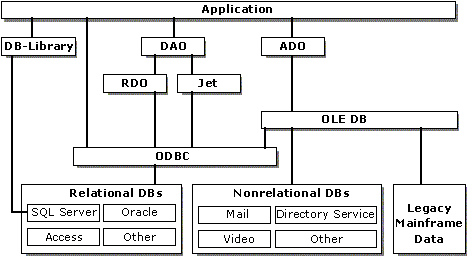
Microsoft products provide several data access connectivity options that are illustrated in the following diagram and summarized in the following discussion.

ODBC, a C/C++ API, is designed to target different sources from the same source code by substituting different drivers. It provides access to server-specific extensions, and developers can write code to query which extensions are available.
Microsoft developed the ODBC interface to provide applications with a single API through which to access data stored in a wide variety of DBMSs. Prior to ODBC, applications written to access data stored in a DBMS had to use the proprietary interface specific to that database. If application developers wanted to provide their users with heterogeneous data access, they had to code to the interface of each data source. Applications written in this manner are difficult to code, maintain, and extend. ODBC was created to overcome these difficulties.
Data Access Object (DAO), which is designed for desktop access to data, is based on the Microsoft Jet database engine technology and uses Jet to gain access to other sources. Jet supports heterogeneous queries by using linked tables. This solution, however, is inefficient because the query processor does not attempt to optimize the query.
Remote Data Objects (RDO) is an object interface to ODBC that is similar to DAO in its programming techniques. RDO is a thin OLE layer on top of ODBC specifically optimized for SQL Server and Oracle databases. It provides a less complex programming model than ODBC, and it is tuned for SQL Server and Oracle access.
ODBCDirect integrates RDO methods directly into DAO, bypassing the Jet engine and thus improving performance. ODBCDirect provides similar features as RDO, but it uses the DAO object model. It offers an easy path to upscale Microsoft Access applications for SQL Server and Oracle.
OLE DB is the foundation of the UDA architecture. It is a specification for a set of COM-based data-access interfaces that encapsulate various data management services, allowing an application to access data without regard to its source. This abstraction of the data-access method provides a more flexible development environment and allows developers to focus their efforts on the application rather than the data. To become an OLE DB provider, you can implement OLE DB components from the OLE DB interfaces for the level of OLE DB support you want. This component-based model allows you to work with data sources in a unified manner and allows for future extensibility.
OLE DB components can be separated into three categories: data providers, data consumers, and service components. A data provider owns the data it exposes to the outside world. Although each OLE DB provider handles implementation details independently, all OLE DB providers expose their data in a tabular format through virtual tables.
A data consumer is any component, whether it be system or application code, that must access data from the OLE DB provider. Development tools, programming languages, and many sophisticated applications fit into this category.
A service component is a logical object that encapsulates a piece of DBMS functionality (such as query processors, cursor engines, or transaction managers). One of the design goals of OLE DB is to implement service components as standalone products that can be plugged in when needed.
ADO is an application-level programming interface to data and information. ADO supports a variety of development needs, including front-end database clients and middle-tier business objects using applications, tools, languages, or browsers. Remote Data Services (RDS), previously known as Active Data Connector, is a client-side component that interfaces with ADO and provides cursors, remote object invocation, and explicit and implicit remote recordset functionality such as fetch and update. OLE DB provides the low-level interface to data across the enterprise.
While ADO interfaces with OLE DB behind the scenes, applications can still access OLE DB directly. And ADO includes the ODBC components that have become the standard for working with relational databases. Although the emphasis in the UDA architecture is on OLE DB native providers, ODBC remains a backward-compatible solution.
RDS is responsible for client-side services such as caching and updating data and binding data to controls. RDS controls use ADO as their data source, and then the cursor engine in RDS communicates with ADO using OLE DB. RDS is a valuable component of the UDA architecture because it is responsible for improving client-side performance and flexibility in the Windows Distributed interNet Applications (DNA) architecture.
The Microsoft DB-Library, a C API, is a set of functions used to create client applications that interact with SQL Server. DB-Library offers the best performance because it is designed to communicate directly with SQL Server, bypassing ODBC and OLE DB. DB-Library is backward-compatible, but it is not the recommended way of connecting to SQL Server.
For more information about connectivity, see the Microsoft Interactive Developer article on Universal Data Access at http://www.microsoft.com/mind/0498/uda/uda.htm.